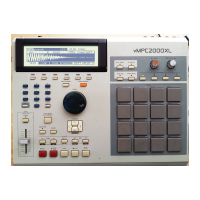Chapter 10: Disk Operation
Page 157
4-1. Saving All Sequences & Songs
This saves all the sequence and song data of the MPC2000XL's memory.
Select Save All Sequence & Songs. The file name will appear in the
File: field.
Press DO IT [F6].
........................................................................................
............................
........................
CANCEL SAVEWIPE
File neme:ALL_SEQ_SONG1File neme:ALL_SEQ_SONG1 .ALL
....................................................................................
Save ALL fileSave ALL file
You can change the file name you are saving in the File name: field.
Tap a drum pad or rotate the DATA wheel to display the Name window.
After entering a name, press the ENTER [F5] key to confirm. If you save without pressing
ENTER [F5 the entered name will be ignored and the file will be saved under the previous
name.
4-2. Saving a Sequence
This saves a sequence data from the MPC2000XL's memory. The MPC2000XL se-
quence data will be saved as a standard MIDI file.
Select Save a Sequence and select the sequence you want to save in the File:
field.
SAVE FORMAT SETUP DO ITLOAD
Type:Save a SequenceType:Save a Sequence
File:08-Sequence08 Size= 10K
Device:Floppy
Free= 21K
.......................................................................................................................
SAVE
Press DO IT [F6].
........................................................................................
............................
........................
CANCEL SAVEWIPE
Save as:MODI FILE TYPE 0Save as:MODI FILE TYPE 0
File:Sequence .MID
....................................................................................
Save a SequenceSave a Sequence
Select the type of standard MIDI file in the Save as: field.
MIDI FILE TYPE 0
The sequence data will be saved together on one track. The MPC2000XL proprietary
track data, such as the track name, will be erased.
MIDI FILE TYPE 1
In contrast to MIDI FILE TYPE 0, data saved in this format will reproduce the condi-
tions of the data. Normally select TYPE 1.
The selected file name will appear in the File: field.

